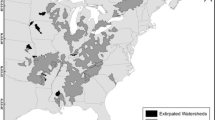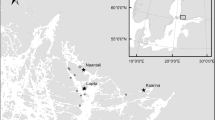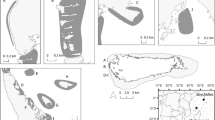Abstract
Understanding how variation in habitat characteristics influences the demography and behavior of organisms is of primary interest in ecological research. I studied how patterns of distribution, abundance, mortality and movement of the fluffy sculpin, Oligocottus snyderi, are related to variation in habitat characteristics within and between sites. The recruitment levels of O. snyderi are very similar at two different intertidal sites, yet post-recruitment processes modify the original recruitment signal at only one of the two sites. The two sites differ significantly in only one measured aspect of their tidepool habitat—the amount of cover provided by surfgrass or algae. Both recruits and adults of O. snyderi exhibit positive associations with the amount of tidepool cover, particularly the presence of surfgrass. A mark-recapture study determined that these differences in the habitat characteristics between the two sites are associated with differences in post-recruitment movement rates. In fact, the absence of a correlation at one site between O. snyderi recruit and adult abundances, which would typically be considered evidence for significant post-recruitment mortality, appears to be driven by strong within-site post-recruitment movement. Furthermore, although post-recruitment mortality rates do not vary significantly across the two sites, variation in post-recruitment mortality is weakly related to within-site variation in tidepool characteristics at one site. The results of this study suggest that post-settlement intertidal fishes continue to sample their surrounding environment as they mature and will redistribute themselves according to within-site spatial variation in habitat characteristics—a behavioral process that may obscure estimates of post-settlement mortality.


Similar content being viewed by others
References
Anderson TW (1994) Role of macroalgal structure in the distribution and abundance of a temperate reef fish. Mar Ecol Prog Ser 113:279–290
Behrents KC (1987) The influence of shelter availability on recruitment and early juvenile survivorship of Lythrypnus dalli Gilbert (Pisces: Gobiidae). J Exp Mar Biol Ecol 107:45–60
Bell SS, McCoy ED, Mushinky HR (1991) Habitat structure: the physical arrangement of objects in space. Chapman & Hall, London
Blizard R (2000) Life histories and otolith microstructure variation of intertidal sculpins. Department of Biology, San Francisco State University, Calif, p 81
Booth DJ, Brosnan DM (1995) The role of recruitment dynamics in rocky shore and coral reef fish communities. Adv Ecol Res 26:309–385
Burnham KP, Anderson DR, White GC, Brownie C, Pollock KH (1987) Design and analysis methods for fish survival experiments based on release-recapture. American Fisheries Society monograph, Bethesda, p 5
Caley MJ, Carr MH, Hixon MA, Hughes TP, Jones GP, Menge BA (1996) Recruitment and the local dynamics of open marine populations. Annu Rev Ecol Syst 27:477–500
Carr MH (1991) Habitat selection and recruitment of an assemblage of temperate zone reef fishes. J Exp Mar Biol Ecol 146:113–137
Clobert J, Lebreton JD, Allainé D (1987) A general approach to survival rate estimation by recaptures or resightings of marked birds. Ardea 75:133–142
Congleton JL (1980) Observations on the responses of some Southern California tide pool fishes to nocturnal hypoxic stress. Comp Biochem Physiol 66:719–722
Connell JH (1972) Community interactions on marine rocky intertidal shores. Annu Rev Ecol Syst 3:169–192
Connell SD, Jones GP (1991) The influence of habitat complexity on postrecruitment processes in a temperate reef fish population. J Exp Mar Biol Ecol 151:271–294
Conradt L, Clutton-Brock TH, Guinness FE (1999) The relationship between habitat choice and lifetime reproductive success in female red deer. Oecologia 120:218–2224
Dahlgren CP, Eggleston DB (2000) Ecological processes underlying ontogenetic habitat shifts in a coral reef fish. Ecology 81:2227–2240
Davis JLD (2000) Spatial and seasonal patterns of habitat partitioning in a guild of southern California tidepool fishes. Mar Ecol Prog Ser 196:253–268
Davis JLD, Levin LA (2002) Importance of pre-recruitment life-history stages to population dynamics of the woolly sculpin Clinocottus analis. Mar Ecol Prog Ser 234:229–246
Dayton PK, Tegner MJ (1984) Catastrophic storms, El Niño, and patch stability in a southern Californian kelp forest community. Science 224:283–285
Ebeling AW, Laur DR (1985) The influence of plant cover on surfperch abundance at an offshore temperate reef. Environ Biol Fishes 12:169–180
Faria C, Almada V (2001) Microhabitat segregation in three rocky intertidal fish species in Portugal: does it reflect interspecific competition? J Fish Biol 58:145–159
Freeman MC, Neally N, Grossman GD (1985) Aspects of the life history of the fluffy sculpin, Oligocottus snyderi. US Natl Mar Fish Serv Fish Bull 83:645–656
Fretwell SD, Lucas HL (1970) On territorial behavior and other factors influencing habitat distribution in birds. I. Theoretical development. Acta Biotheor 19:16–36
Gibson RN (1982) Recent studies on the biology of intertidal fishes. Oceanogr Mar Biol Annu Rev 20:363–414
Gibson RN, Yoshiyama RM (1999) Intertidal fish communities. In: Horn MH, Martin KLM, Chotkowski MA (eds) Intertidal fishes: life in two worlds. Academic Press, San Diego, pp 264–296
Hixon MA, Beets JP (1993) Predation, prey refuges and the structure of coral reef fish assemblages. Ecol Monogr 63:77–101
Holbrook SJ, Carr MH, Schmitt RJ, Coyer JA (1990) Effect of giant kelp on local abundance of reef fishes—the importance of ontogenetic resource requirements. Bull Mar Sci 47:104–114
Huey R (1989) Hot rocks and not-so-hot rocks: retreat-site selection by garter snakes and its thermal consequences. Ecology 70:931–944
Huey RB (1991) Physiological consequences of habitat selection. Am Nat 137:S91–S115
Jenkins GP, Keough MJ, Hamer PA (1998) The contributions of habitat structure and larval supply to broad-scale recruitment variability in a temperate zone, seagrass-associated fish. J Exp Mar Biol Ecol 226:259–278
Jones GP (1984) The influence of habitat and behavioural interactions on the local distribution of the wrasse, Pseudolabrus celidotus. Environ Biol Fishes 10:43–58
Levin PS (1993) Habitat structure, conspecific presence and spatial variation in the recruitment of a temperate reef fish. Oecologia 94:176–185
Levin PS, Hay ME (1996) Responses of temperate reef fishes to alterations in algal structure and species composition. Mar Ecol Prog Ser 134:37–47
Littell RC, Freund RJ, Spector PC (1991) SAS system for linear models, 3rd edn. SAS Institute, Cary
Lubchenco J (1980) Algal zonation in the New England rocky intertidal community: an experimental analysis. Ecology 61:333–344
Menge BA, Sutherland JP (1976) Species diversity gradients: synthesis of the roles of predation competition and temporal heterogeneity. Am Nat 110:351–369
Morris DW, Davidson DL (2000) Optimally foraging mice match patch use with habitat differences in fitness. Ecology 81:2061–2066
Morris RW (1960) Temperature, seasonality, and southern limits of three species of Pacific cottid fishes. Limnol Oceanogr 5:175–179
Nakamura R (1976a) Experimental assessment of factors influencing microhabitat selection by two tidepool fishes Oligocottus maculosus and O. snyderi. Mar Biol 37:97–104
Nakamura R (1976b) Temperature and the vertical distribution of two tidepool fishes (Oligocottus maculosus, O. snyderi). Copeia 1976:143–152
Nieder J (2000) Depth of sojourn and niche differentiation of benthic blennies (Pisces, Blenniidae) in the Mediterranean Sea (Catalonia, NE Spain and Italian coast of the Tyrrhenian Sea). Misc Zool 23:21–33
Orians GH, Wittenberger JF (1991) Spatial and temporal scales in habitat selection. Am Nat 137:S29–S49
Petit LJ, Petit DR (1996) Factors governing habitat selection by prothonotary warblers: field tests of the Fretwell–Lucas models. Ecol Monogr 66:367–387
Pfister CA (1995) Estimating competition coefficients from census data: a test with field manipulations of tidepool fishes. Am Nat 146:271–291
Pfister CA (1996) The role and importance of recruitment variability to a guild of tide pool fishes. Ecology 77:1928–1941
Pfister CA (2006) Concordance between short-term experiments and long-term censuses in tide pool fishes. Ecology 87:2905–2914
Polivka KM, Chotkowski MA (1998) Reeolonization of experimentally defaunated tidepools by northeast Pacific intertidal fishes. Copeia 456–462
Pulliam HR, Danielson BJ (1991) Sources, sinks, and habitat selection: a landscape perspective on population dynamics. Am Nat 137:S50–S66
Quinn GP, Keough MJ (2002) Experimental design and data analysis for biologists. Cambridge University Press, Cambridge
Rickhus W (1981) Laboratory studies of intraspecific behavioral interactions and factors influencing tidepool selection of the woolly sculpin, Clinocottus analis. Calif Fish Game 67:187–195
Ritter AF, Preisler RK (2006) Spatial variation in structure of an intertidal fish assemblage reflects daily settlement patterns. Mar Ecol Prog Ser 317:211–223
Ritter AF (2005) The influence of processes at different scales on the population dynamics of intertidal fishes. Department of Ecology and Evolutionary Biology, University of California, Santa Cruz, p 203
Rosenzweig ML (1991) Habitat selection and population interactions: the search for mechanism. Am Nat 137:S5–S28
Schmitt RJ, Holbrook SJ (1985) Patch selection by juvenile black surfperch (Embiotoca jacksoni) (Embiotocidae) under variable risk: interactive influence of food quality and structural complexity. J Exp Mar Biol Ecol 85:269–286
Sih A (1987) Prey refuges and predator–prey stability. Theor Popul Biol 31:1–12
Silberschneider V, Booth DJ (2001) Resource use by Enneapterygius rufopileus and other rockpool fishes. Environ Biol Fishes 61:195–204
Sogard SM, Able KW, Hagan SM (2001) Long-term assessment of settlement and growth of juvenile winter flounder (Pseudopleuronectes americanus) in New Jersey estuaries. J Sea Res 45:189–204
Steele MA (1999) Effects of shelter and predators on reef fishes. J Exp Mar Biol Ecol 233:65–79
Syms C (1995) Multi-scale analysis of habitat association in a guild of blennioid fishes. Mar Ecol Prog Ser 125:31–43
Szabo AR (2002) Experimental tests of intercohort competition for food and cover in the tidepool sculpin (Oligocottus maculosus). Can J Zool 80:137–144
Tremblay I, Thomas DW, Lambrechts MM, Blondel J, Perret P (2003) Variation in blue tit breeding performance across gradients in habitat richness. Ecology 84:3033–3043
Tupper M, Boutilier RG (1997) Effects of habitat on settlement, growth, predation risk and survival of a temperate reef fish. Mar Ecol Prog Ser 151:225–236
Underwood AJ, Chapman MG (2000) Variation in abundances of intertidal populations: consequences of extremities of environment. Hydrobiologia 426:25–36
Washington B, Moser H, Laroch W, Richards W (1984) Scorpaeniformes: development. In: Ontogeny and systematics of fishes. American Society of Ichthyologists and Herpetologists
Webster MS, Osborne-Gowey JD, Young TH, Freidenburg TL, Menge BA (2007) Persistent regional variation in populations of a tidepool fish. J Exp Mar Biol Ecol 346:8-20
Wellington GM, Victor BC (1988) Variation in components of reproductive success in an undersaturated population of coral reef damselfish—a field perspective. Am Nat 131:588–601
Werner EE, Gilliam JF, Hall DJ, Mittelbach GG (1983) An experimental test of the effects of predation risk on habitat use in fish. Ecology 64:1540–1548
White KP, Burnham GC (1999) Program MARK: survival estimation from populations of marked animals. Bird Study 46(Suppl):120–138
Yoshiyama RM (1981) Distribution and abundance patterns of rocky intertidal fishes in central California. Environ Biol Fishes 6:315–332
Yoshiyama RM, Sassaman C, Lea RN (1986) Rocky intertidal fish communities of California: temporal and spatial variation. Environ Biol Fishes 17:23–40
Zander CD, Nieder J, Martin KL (1999) Vertical distribution patterns. In: Horn MH, Martin KLM, Chotkowski MA (eds) Intertidal fishes: life in two worlds. Academic Press, San Diego, pp 26–53
Acknowledgements
I thank M. Carr, D. Doak, C. Syms, P. Raimondi, J. Clobert, and A. Chaine for comments on this manuscript and help with statistical and demographic analyses. I also thank numerous UCSC senior thesis and independent study students and volunteers who assisted with the field research. This work was supported by the Project for Interdisciplinary Studies of the Coastal Oceans (PISCO) funded by the David and Lucile Packard Foundation, University of California Office of the President, Center for Dynamics of the Land Sea Interface (UCSC), Myers Oceanographic Trust, and Friends of Long Marine Laboratory (UCSC). This is contribution #298 from PISCO. The experiments in this manuscript comply with the current laws of California and the USA.
Author information
Authors and Affiliations
Corresponding author
Additional information
Communicated by Michael Keough.
Electronic supplementary material
Below is the link to the electronic supplementary material.
Rights and permissions
About this article
Cite this article
Ritter, A.F. Habitat variation influences movement rates and population structure of an intertidal fish. Oecologia 157, 429–439 (2008). https://doi.org/10.1007/s00442-008-1086-y
Received:
Accepted:
Published:
Issue Date:
DOI: https://doi.org/10.1007/s00442-008-1086-y




